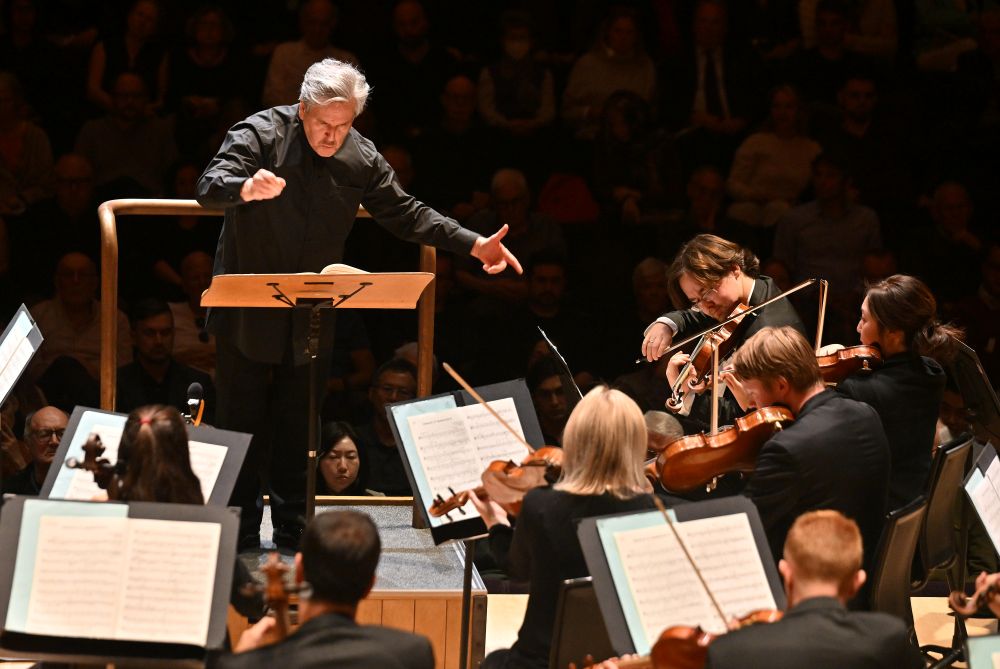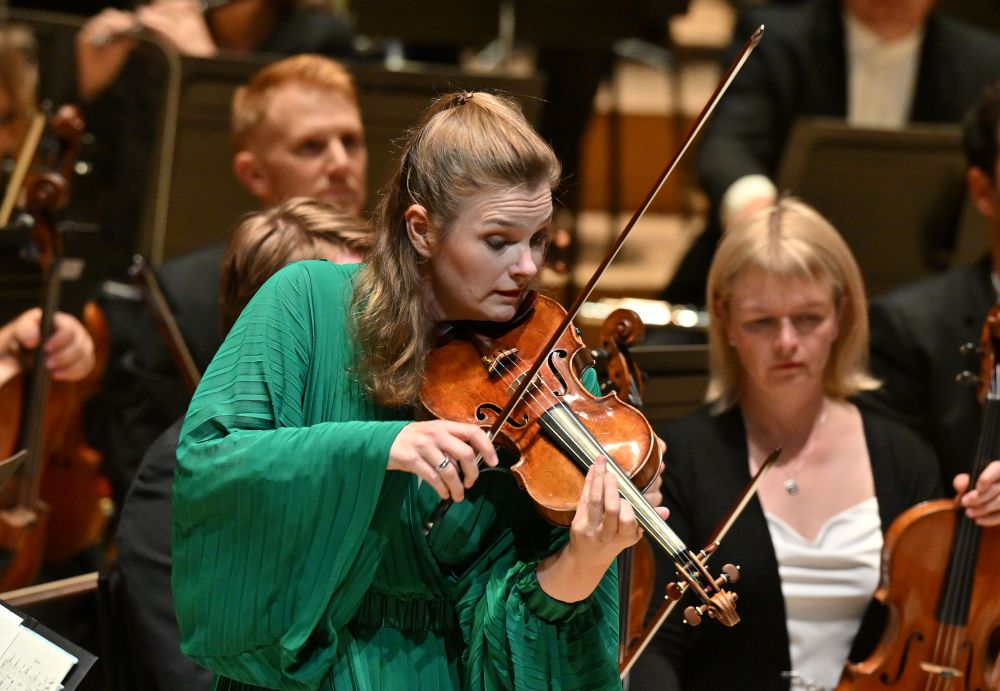Jansen, LSO, Pappano, Barbican review - profound and bracing emotional workouts | reviews, news & interviews
Jansen, LSO, Pappano, Barbican review - profound and bracing emotional workouts
Jansen, LSO, Pappano, Barbican review - profound and bracing emotional workouts
Great soloist, conductor and orchestra take Britten and Shostakovich to the edge

Antonio Pappano and the London Symphony Orchestra last seared us in Britten’s amazing Violin Concerto, with Vilde Frang as soloist, on the very eve of lockdown in 2020. The work’s dying fall then was echoed by the spectral drift ending Vaughan Williams’ Sixth Symphony. This time Frang’s equal as the greatest of violinists, Janine Jansen, faced the daunting solo role fearlessly, and the riproaring end of Shostakovich’s Tenth Symphony proved that this team is here to stay.
There were telling links with Thursday’s concert, too. Britten’s emotional demands are as challenging as Prokofiev’s in the Second Piano Concerto, impressively face by Seong-Jin Cho last week. And Pappano’s singular way with Shostakovich’s Ninth Symphony paved the way for the longer-term challenges of the Tenth; in the earlier work, the woodwind soloists went to extremes of desolation and quiet dynamics in a second movement which became an Adagio. Last night Pappano must have persuaded them that there's no end to the work you can do on emotional articulation, because it seemed impossible to do more, to go deeper.
Attribute a certain post-Britten exhaustion to the fact that I admired the incredibly detailed phrasing and unerring shape, always moving forward without over-urging, of Shostakovich's massive first movement at a slight distance. But a great interpretation can always recharge you, and from the digging deep of those ever more extraordinary LSO strings in the whirlwind scherzo onwards, I felt deep inside the music. Its purgatorial successor somehow managed to turn the emotional screw still further, from the horn call trying to assert a bigger world onwards.  As on Thursday, Pappano fielded a mostly different woodwind team from the first half, though Gareth Davies' flute was there again to intensify Juliana Koch's plaintive oboe solo. The evening's leader, Benjamin Gilmore, managed to register a spectral klezmer solo before Pappano took us straight on to further desolation in the finale, offering no jolt in the turn to jolly but short-lived relief. Commenters often want to insist that this finale, like those in Mahler's Fifth and Seventh Symphonies, is ironic, but you should feel an immense if frenetic exultation in the final bars; after all, though he typically didn't expect things to suddenly become much better, Shostakovich clearly felt new life with the death of Stalin in 1953.
As on Thursday, Pappano fielded a mostly different woodwind team from the first half, though Gareth Davies' flute was there again to intensify Juliana Koch's plaintive oboe solo. The evening's leader, Benjamin Gilmore, managed to register a spectral klezmer solo before Pappano took us straight on to further desolation in the finale, offering no jolt in the turn to jolly but short-lived relief. Commenters often want to insist that this finale, like those in Mahler's Fifth and Seventh Symphonies, is ironic, but you should feel an immense if frenetic exultation in the final bars; after all, though he typically didn't expect things to suddenly become much better, Shostakovich clearly felt new life with the death of Stalin in 1953.
The Tenth felt like a vigilant grey wolf, colourwise, after Britten's variegated creature in the Violin Concerto. It sounds like he knew Shostakovich's more audaciously scored Fourth Symphony, though that of course had to wait until the 1960s for its premiere (was there a score around in the 1930s, I wonder?) The moment where upper wind twitter and a tuba stalks up from the depths is a unique moment that still wouldn't have been possible without Shostakovich's example. But Britten's mastery is there from the start in the timpani rhythm and cymbal clashes subject to so many different treatments in the preludial but theme-rich first movement.  Jansen, always watching and listening to her orchestral colleagues, kicked off the heightened tension levels with the central cadenza linking scherzo and finale, looking back also to the first idea, and the orchestra responded in the early passacaglia/chaconne variations, exploiting rising and falling scales with total originality, spine-chillingly so as trumpet soloist Imogen Whitehead turned another screw. What an originally and perfectly constructed masterpiece this is, easily up there with the 20th century's greatest specimens by Sibelius, Stravinsky and Shostakovich, down to the extended epilogue where Jansen, like Frang before here, took us on a further emotional journey towards the unknown regions. Her encore, the Sarabande from Bach's Partita No. 2, played like everything else to an impressively, intensely quiet audience, was simply perfect: this is the artist I want to hear play the complete Bach solo music for violin live.
Jansen, always watching and listening to her orchestral colleagues, kicked off the heightened tension levels with the central cadenza linking scherzo and finale, looking back also to the first idea, and the orchestra responded in the early passacaglia/chaconne variations, exploiting rising and falling scales with total originality, spine-chillingly so as trumpet soloist Imogen Whitehead turned another screw. What an originally and perfectly constructed masterpiece this is, easily up there with the 20th century's greatest specimens by Sibelius, Stravinsky and Shostakovich, down to the extended epilogue where Jansen, like Frang before here, took us on a further emotional journey towards the unknown regions. Her encore, the Sarabande from Bach's Partita No. 2, played like everything else to an impressively, intensely quiet audience, was simply perfect: this is the artist I want to hear play the complete Bach solo music for violin live.
The future of Arts Journalism
You can stop theartsdesk.com closing!
We urgently need financing to survive. Our fundraising drive has thus far raised £49,000 but we need to reach £100,000 or we will be forced to close. Please contribute here: https://gofund.me/c3f6033d
And if you can forward this information to anyone who might assist, we’d be grateful.

Subscribe to theartsdesk.com
Thank you for continuing to read our work on theartsdesk.com. For unlimited access to every article in its entirety, including our archive of more than 15,000 pieces, we're asking for £5 per month or £40 per year. We feel it's a very good deal, and hope you do too.
To take a subscription now simply click here.
And if you're looking for that extra gift for a friend or family member, why not treat them to a theartsdesk.com gift subscription?
more Classical music
 Jansen, LSO, Pappano, Barbican review - profound and bracing emotional workouts
Great soloist, conductor and orchestra take Britten and Shostakovich to the edge
Jansen, LSO, Pappano, Barbican review - profound and bracing emotional workouts
Great soloist, conductor and orchestra take Britten and Shostakovich to the edge
 Jakub Hrůša and Friends in Concert, Royal Opera review - fleshcreep in two uneven halves
Bartók kept short, and a sprawling Dvořák choral ballad done as well as it could be
Jakub Hrůša and Friends in Concert, Royal Opera review - fleshcreep in two uneven halves
Bartók kept short, and a sprawling Dvořák choral ballad done as well as it could be
 Hadelich, BBC Philharmonic, Storgårds, Bridgewater Hall, Manchester review - youth, fate and pain
Prokofiev in the hands of a fine violinist has surely never sounded better
Hadelich, BBC Philharmonic, Storgårds, Bridgewater Hall, Manchester review - youth, fate and pain
Prokofiev in the hands of a fine violinist has surely never sounded better
 Monteverdi Choir, ORR, Heras-Casado, St Martin-in-the-Fields review - flames of joy and sorrow
First-rate soloists, choir and orchestra unite in a blazing Mozart Requiem
Monteverdi Choir, ORR, Heras-Casado, St Martin-in-the-Fields review - flames of joy and sorrow
First-rate soloists, choir and orchestra unite in a blazing Mozart Requiem
 Cho, LSO, Pappano, Barbican review - finely-focused stormy weather
Chameleonic Seong-Jin Cho is a match for the fine-tuning of the LSO’s Chief Conductor
Cho, LSO, Pappano, Barbican review - finely-focused stormy weather
Chameleonic Seong-Jin Cho is a match for the fine-tuning of the LSO’s Chief Conductor
 Classical CDs: Shrouds, silhouettes and superstition
Cello concertos, choral collections and a stunning tribute to a contemporary giant
Classical CDs: Shrouds, silhouettes and superstition
Cello concertos, choral collections and a stunning tribute to a contemporary giant
 Appl, Levickis, Wigmore Hall review - fun to the fore in cabaret and show songs
A relaxed evening of light-hearted fare, with the accordion offering unusual colours
Appl, Levickis, Wigmore Hall review - fun to the fore in cabaret and show songs
A relaxed evening of light-hearted fare, with the accordion offering unusual colours
 Lammermuir Festival 2025, Part 2 review - from the soaringly sublime to the zoologically ridiculous
Bigger than ever, and the quality remains astonishingly high
Lammermuir Festival 2025, Part 2 review - from the soaringly sublime to the zoologically ridiculous
Bigger than ever, and the quality remains astonishingly high
 BBC Proms: Ehnes, Sinfonia of London, Wilson review - aspects of love
Sensuous Ravel, and bittersweet Bernstein, on an amorous evening
BBC Proms: Ehnes, Sinfonia of London, Wilson review - aspects of love
Sensuous Ravel, and bittersweet Bernstein, on an amorous evening
 Presteigne Festival 2025 review - new music is centre stage in the Welsh Marches
Music by 30 living composers, with Eleanor Alberga topping the bill
Presteigne Festival 2025 review - new music is centre stage in the Welsh Marches
Music by 30 living composers, with Eleanor Alberga topping the bill
 Lammermuir Festival 2025 review - music with soul from the heart of East Lothian
Baroque splendour, and chamber-ensemble drama, amid history-haunted lands
Lammermuir Festival 2025 review - music with soul from the heart of East Lothian
Baroque splendour, and chamber-ensemble drama, amid history-haunted lands
 BBC Proms: Steinbacher, RPO, Petrenko / Sternath, BBCSO, Oramo review - double-bill mixed bag
Young pianist shines in Grieg but Bliss’s portentous cantata disappoints
BBC Proms: Steinbacher, RPO, Petrenko / Sternath, BBCSO, Oramo review - double-bill mixed bag
Young pianist shines in Grieg but Bliss’s portentous cantata disappoints

Add comment